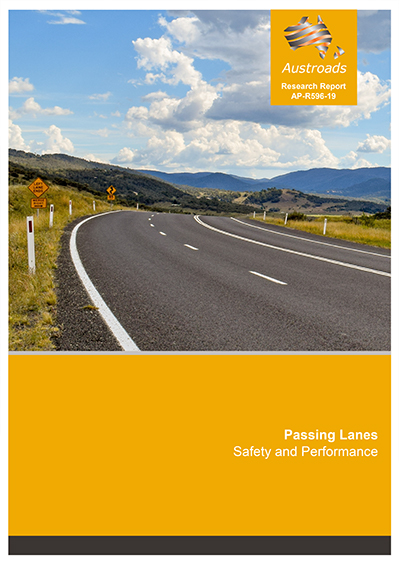Traffic Management

Passing Lanes: Safety and Performance
- Publication no: AP-R596-19
- ISBN: 978-1-925671-95-7
- Published: 15 January 2019
- PDF (free) Download
This report examines the impacts of passing lanes on safety, journey time and user experience and provides guidance to assist in the development of passing lane installation projects.
The research found that passing lanes result in safety benefits, including perceived safety by motorists, safer operational conditions, and historical crash reductions. Passing lanes were also found to improve journey times through a small increase in travel speed and a significant reduction in percentage of time spent following a slower vehicle.
This project included a
- literature review
- safety analysis, before-and-after analysis of crash records, speed and headway analysis, and overtaking behaviour analysis
- journey time analysis, including development of modelling guidance and numerical experiments on the impact of passing lanes on travel speed and per cent time spent following
- road user experience survey analysis, including an analysis of perceptions and valuation of level-of-service
- a review and re-calibration of the TRAffic on Rural Roads (TRARR) model.
- Summary
- 1. Introduction
- 1.1 Objectives
- 1.2 Scope
- 2. Literature Review
- 2.1 Passing Lanes
- 2.1.1 Key Design Features
- 2.1.2 Warrants
- 2.1.3 Level-of-service and Capacity
- 2.2 Journey Experience
- 2.2.1 Impact of Passing Lanes
- 2.2.2 Design Impacts on Performance
- 2.2.3 Modelling of Journey Experience
- 2.3 Safety
- 2.3.1 Passing Lane Design and Safety
- 2.3.2 Safety Effects of Passing Lanes
- 2.3.3 Summary
- 2.4 User Expectations
- 2.1 Passing Lanes
- 3. Safety Benefit Assessment
- 3.1 Crash Data Analysis
- 3.1.1 Method
- 3.1.2 Results
- 3.1.3 Limitations
- 3.2 Lane-use, Speed and Headway Analysis
- 3.2.1 Method
- 3.2.2 Results
- 3.3 Overtaking, Speed and Gap Analysis
- 3.3.1 Method
- 3.3.2 Results
- 3.4 Discussion
- 3.1 Crash Data Analysis
- 4. Journey Time Assessment
- 4.1 Modelling Techniques
- 4.1.1 HCM Method
- 4.1.2 TRARR Method
- 4.1.3 Comparison of TRARR and HCM
- 4.2 TRARR Review and Calibration
- 4.2.1 Method
- 4.2.2 Field Data
- 4.2.3 Calibration and Validation
- 4.2.4 Recommended Parameters
- 4.2.5 Sensitivity Analysis of Headway Thresholds for PTSF
- 4.3 Numerical Analysis
- 4.3.1 Highway and Demand Attributes
- 4.3.2 Passing Lane Density
- 4.3.3 Passing Lane Length
- 4.4 Discussion
- 4.1 Modelling Techniques
- 5. User Experience
- 5.1 Surveys
- 5.1.1 Route-specific Travel Experience Survey
- 5.1.2 General Travel Experience Survey
- 5.2 Reported Journey Experience and TRARR Estimates
- 5.3 Perception of PTSF
- 5.4 Valuation of PTSF
- 5.4.1 Route-specific Survey Results
- 5.4.2 Generic Survey Results
- 5.5 Perceptions of Safety
- 5.6 Effect of Travel Information
- 5.1 Surveys
- 6. Conclusions
- 6.1 Safety Impacts
- 6.2 Journey Time Impacts
- 6.3 User Experience
- 6.4 Recommendations for Future Research
- 6.4.1 Variance in Passing Lane Crash Impacts
- 6.4.2 TRARR Calibration for High Traffic Volume Conditions
- 6.4.3 Extended User Experience Survey and Analysis
- 6.4.4 Updates to the Guides
- References
- Appendix A Crash Data Analysis
- Appendix B Calibrated Traffic Parameters (Template for TRF File)
- Appendix C Calibrated Vehicle Parameters (VEHS File)
- Appendix D Survey
- Appendix E Review of the Impacts to Austroads Guides
Related publications
WEB-R596-19
Latest Traffic Management News
